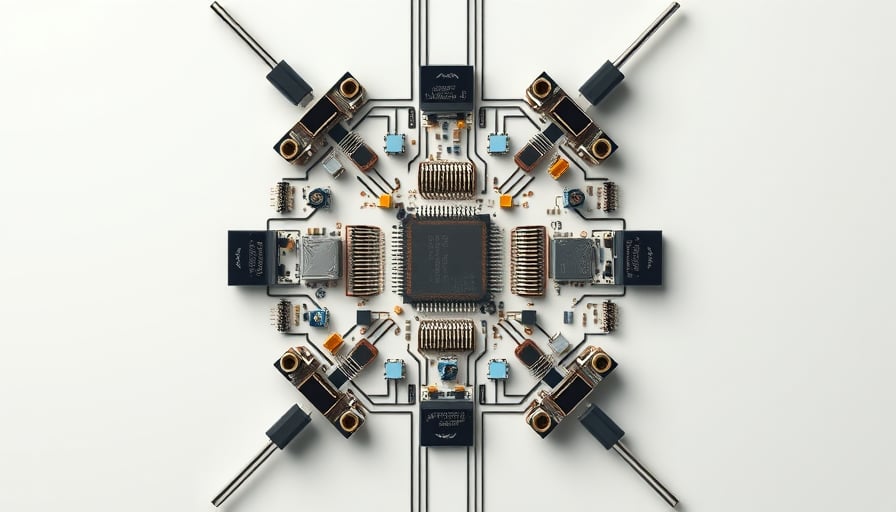Market Impact of STMicroelectronics’ Recent Earnings Announcement
The recent earnings disclosure from STMicroelectronics NV has triggered a pronounced sell‑off in the company’s shares, with the stock falling nearly 14 % within a matter of days. The decline is chiefly attributed to a downgraded fourth‑quarter revenue forecast and subsequent revisions of analyst price targets. The event underscores the fragility of semiconductor valuations amid shifting demand dynamics, supply‑chain uncertainties, and heightened sensitivity to macroeconomic signals.
Revenue Outlook and Analyst Revisions
STMicroelectronics reported a weaker than anticipated revenue outlook for the fourth quarter, a development that prompted several key analysts to recalibrate their expectations:
| Analyst | Previous Target | Revised Target |
|---|---|---|
| JPMorgan | EUR 26.40 | EUR 24 |
| TD Cowen | USD 25 | USD 25 (unchanged, but noted in the context of market sentiment) |
The 3 % downward adjustment by JPMorgan, while modest in absolute terms, reflects a broader reassessment of the company’s near‑term growth trajectory. The downgrade suggests concerns over the resilience of the automotive and industrial semiconductor segments, where STMicroelectronics holds substantial market share but faces intensifying competition from firms such as Infineon and NXP.
Volatility in the European Semiconductor Landscape
European markets, buoyed by a modest uptick in broader indices, could not shield STMicroelectronics from its own valuation pressures. The volatility observed in the company’s share price is not an isolated phenomenon; it mirrors a sector‑wide trend where semiconductor stocks oscillate between exuberant gains and sharp declines, often in response to quarterly earnings reports, geopolitical developments, and supply‑chain disruptions.
- Positive Days: In the week following the earnings release, the stock rebounded by up to 5 % on speculation that the company’s R&D pipeline might offset short‑term revenue shortfalls.
- Negative Days: Conversely, the same week saw a 9 % dip as market participants recalibrated expectations for the upcoming fiscal year.
Implications for Technology Trends
The volatility raises critical questions about the interplay between technology evolution and market stability:
Shift Toward Automotive Electronics
STMicroelectronics’ revenue mix is increasingly tied to automotive silicon—particularly for advanced driver‑assist systems (ADAS) and power‑train control. A slowdown in global vehicle production or a pivot toward alternative power sources could erode demand. The company’s revenue downgrade may, therefore, reflect a cautious stance toward the automotive sector’s recovery post‑pandemic.Supply‑Chain Constraints
Semiconductor supply chains have been under unprecedented strain. Delays in key materials, geopolitical tensions, and raw‑material price volatility could exacerbate production bottlenecks. A weakened revenue outlook may partly stem from anticipated capacity constraints that could impede the firm’s ability to meet demand.Innovation Versus Execution
While STMicroelectronics boasts a robust portfolio—spanning sensors, analog ICs, and digital solutions—the firm’s ability to translate R&D breakthroughs into commercial success is being scrutinized. Analysts are probing whether executive strategy and market positioning can sustain the company’s long‑term growth trajectory.
Risks and Opportunities for Stakeholders
Investors face heightened price volatility and potential mispricing of the stock if the revenue outlook remains uncertain. The lowered price targets signal a conservative view, suggesting that value‑investors may reassess their exposure.
Employees and suppliers may experience downstream effects. A slowdown in order volumes could lead to reduced hiring or contract renegotiations, impacting regional economies that depend on the semiconductor supply chain.
Consumers could ultimately see price pressure on electronics and automotive products if supply constraints translate into higher component costs. Conversely, an intensified focus on energy efficiency and electric mobility could spur new product lines that offset short‑term revenue dips.
Broader Societal and Privacy Considerations
The semiconductor sector’s evolution is intertwined with privacy and security concerns. As automotive and industrial devices become increasingly connected, the potential for data breaches or cyber‑physical attacks escalates. A company’s financial health directly influences its capacity to invest in robust security architectures:
- A strained budget may curtail investment in secure firmware updates and encryption.
- Talent retention becomes critical; the loss of senior engineers can slow the development of secure design practices.
Moreover, the environmental footprint of semiconductor manufacturing—particularly energy consumption and waste management—continues to be scrutinized. A company’s profitability can dictate the aggressiveness of its sustainability initiatives, potentially affecting compliance with global environmental regulations and public perception.
Looking Ahead
Analysts anticipate that STMicroelectronics’ share price will remain volatile in the immediate future, contingent upon:
- The clarity of subsequent quarterly earnings and guidance updates.
- Geopolitical developments that may affect trade policies and supply chains.
- The trajectory of the automotive industry, especially as it navigates the transition to electric vehicles.
In a sector where technological momentum often outweighs short‑term earnings fluctuations, the interplay between strategic investment and market perception will be crucial. Stakeholders must weigh the company’s current valuation against its capacity to innovate and adapt in an era of rapid digital transformation, heightened cybersecurity demands, and evolving consumer expectations.
